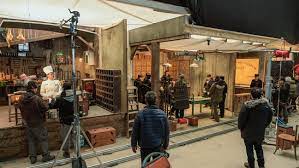The Art Department
Welcome to our series of articles about Video and Film Production crew. Whether you want to be in the industry, or just want to learn more about filmmaking, we will provide you with all the information you need right here. Today we are talking about the Art Department, with a focus on set decorating and Mise-en-scène.
Who comprises the Art Department?
These are only some of the many roles within a film’s art department. This of course depends on the size and budget of the production, for example a short, low budget will most likely only have a production designer, who doubles as the art director and possibly has an assistant. Whereas larger production will often construct and create a set from scratch.
Production Designer
The production designer essentially creates the entire visual appearance of the film. The plan the colour scheme, mise-en-scène and general aesthetic. They have to work closely with the rest of the art department, as well as costume, makeup and lighting and of course the Director of Photography.
Art Director
The art director supervises the design and planning of the film set and all things included in it. They carefully analyse the script, keeping notes of all props, furniture and other pieces needed for the set. They keep track of what requires further designing, building or purchasing. They then pass on this information to the rest of the art department team and the construction department. They also maintain the sets, scheduling and managing the creation, rebuilding, dressing and striking of all locations and sets.
Assistant Art Director
The assistant art director helps bring the art director and production designer’s plans to life. They gather all necessary information such as measurements and in some cases prop costs. They research and sometimes make props for the mise-en-scène, and on larger projects they may manage the small locations or sets of the film.
Set Dresser / Decorator
The set dresser does exactly what it sounds like, they dress the set and create the mise-en-scène. They are responsible for placing and removing all props and decorations on the set or location. This includes everything from small items, posters and plants, to furniture, carpets, curtains and more.
Buyer
The buyer is in charge of purchasing and renting all set items. They communicate with shops and rental houses to book and plan purchases and deliveries in time for a shoot.
Props Master / Maker
On a larger production, the art department will have a Prop Master, who is in charge of making, storing, transporting and prepping all props for the shoots. They work closely with the production designer, set dresser and art director to figure out what props are needed for the set.
Construction Coordinator
The construction coordinator supervises the construction department, ordering all necessary materials, scheduling shifts and overseeing the building of sets.
Carpenters
This one’s another obvious one. Carpenters handle all wood work during set construction, they build, install and remove all the structures. In some cases they may also create wooden furniture and other props for the set.
Painters
The painters, as you’d expect are responsible for painting the set’s surfaces and any miniatures or models included. Their work depends on the project and what the art department requires of them, which could include priming, finishing and potentially marbling and graining.
How to get into Art Department work?
Like in most film jobs you’ll probably have to start out with a traineeship. The specifics depend on what role you plan on going into, for example if you’re interested in carpentry you’ll need a carpentry qualification, but if you want to be an art director you can start out as an art department trainee. You can find useful tips on how to find these opportunities, and what requirements you’ll need beforehand on this ScreenSkills page.
Essentially you’ll have to just build your portfolio and network as with any other film job. So start by educating yourself on the art department, build your skills and meet people in the industry.
To get more information in becoming a sound recordist, visit: Screenskills, How to get into sound. Go to ScreenSkills information on apprenticeships for the main apprenticeship schemes in television. learn how to build your sound portfolio.
You can also read the rest of our series on the Nostairway website, like our article on Boom Operating and on Camera Department work.
As a video production company in London, we often get asked how much it would cost to produce a video ourselves. The truth is, with the right equipment and some know-how, you can save a lot of money by creating your own videos. Of course, there is an initial investment involved in purchasing the necessary equipment.
However, once you have your own set-up, the sky is the limit in terms of what you can create. And if you’re willing to put in the time to learn the ropes, you can start producing high-quality videos that will save you money in the long run. So if you’re looking to create video content on a budget, don’t be afraid to go DIY. With a little effort, you can create professional-grade videos that will help you save money and reach your target audience.





Recent Comments